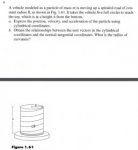Sorry, first time using this site.

I was looking for help with the above problem. I'm not so concerned with solving part b, but more just finding the right equations for part a.
If there is an equation editor for this site, let me know.
I know z=(h*theta)/(2*pi), and I know the below equations from the notes, where e_R, e_theta, and k are the cylindrical coordinates.
r(t) = R*e_R + z*k
v(t) = R'*e_R + R*(theta')*e_theta + z'*k
a(t) = (R''-R*theta'^2)*e_R + (R*theta'' + 2*R'*theta')*e_theta + z''*k
The problem is, I don't know a second equation that relates theta (or z) to the known values (m, R, and h). In the similar example problem, they had two equations they used to relate the knowns to z and theta (attached below).

Any help figuring this part of the problem out would be appreciated!

I was looking for help with the above problem. I'm not so concerned with solving part b, but more just finding the right equations for part a.
If there is an equation editor for this site, let me know.
I know z=(h*theta)/(2*pi), and I know the below equations from the notes, where e_R, e_theta, and k are the cylindrical coordinates.
r(t) = R*e_R + z*k
v(t) = R'*e_R + R*(theta')*e_theta + z'*k
a(t) = (R''-R*theta'^2)*e_R + (R*theta'' + 2*R'*theta')*e_theta + z''*k
The problem is, I don't know a second equation that relates theta (or z) to the known values (m, R, and h). In the similar example problem, they had two equations they used to relate the knowns to z and theta (attached below).

Any help figuring this part of the problem out would be appreciated!
